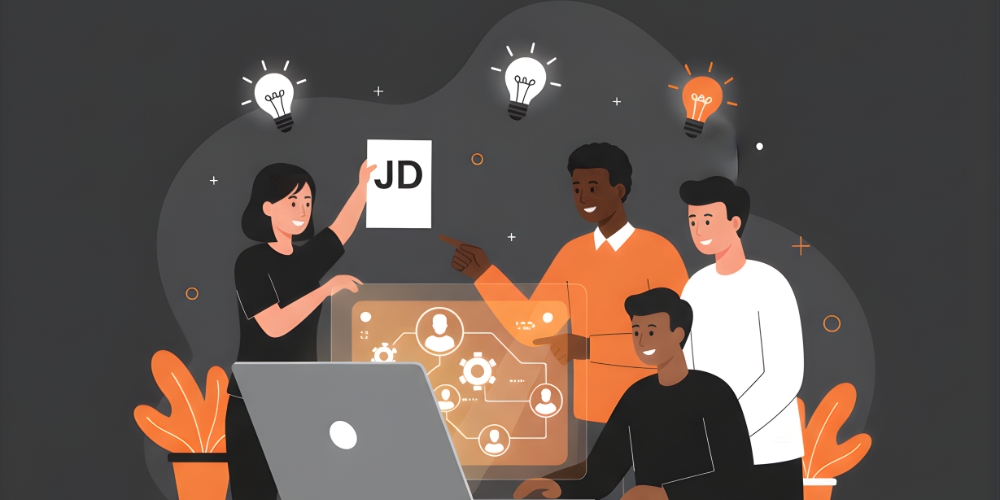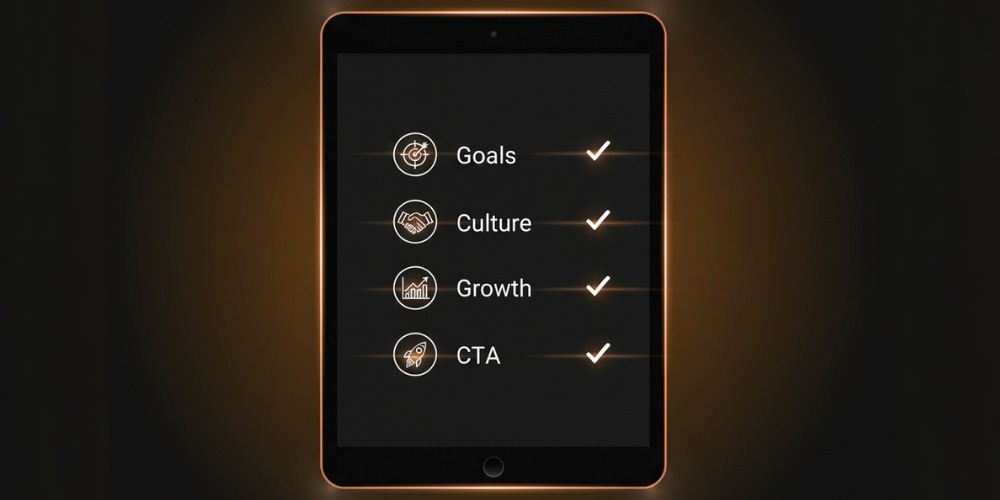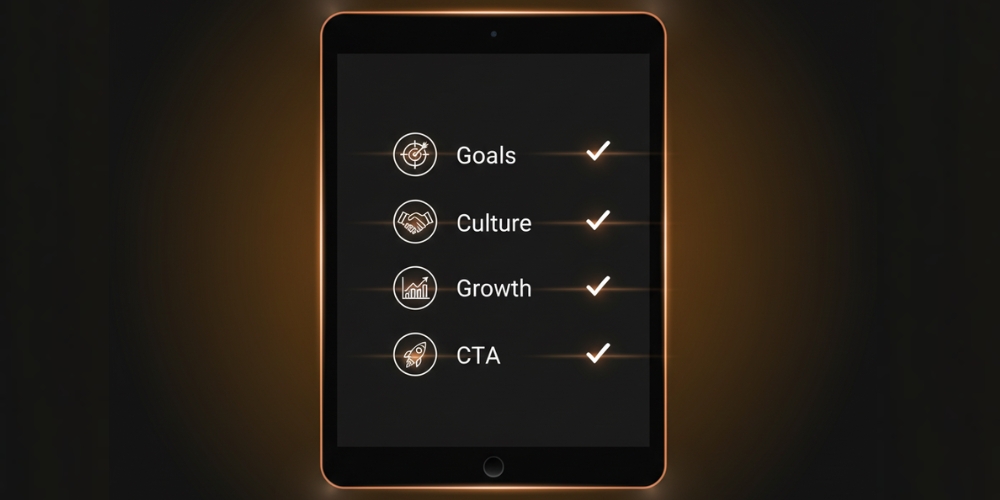
TL;DR
- Write your job description for a startup company to match real needs.
- Show how startup company roles differ from corporate ones.
- Highlight growth, outcomes and adaptability when writing startups descriptions.
- Keep it human. No buzzwords like “rockstar” or “ninja.”
- Drop the words to avoid when writing a job description that sound fake.
- Make it appealing to those who thrive in chaos and attract the right candidates.
- Use SEO-friendly text and job description technology tools to boost reach.
- Help job seekers understand how to get job at startup through clarity.
- Strong startup JDs cut bad hires and speed up recruitment.
Hiring at a young company can feel like setting sail without a map. You know you need someone who can roll up their sleeves, jump across functions and learn fast. That’s why your job description for startup company has to be more than a list of tasks. It must clearly signal the kind of person you truly need.
This guide shows you how to write a job description that connects with real motivations, fits startup company roles and supports team growth. You will also see what makes startup positions different, what to include in a strong description and how to skip the usual mistakes.
Why Job Descriptions Matter Even More for Startups

Every hire shapes a startup in a big way. The wrong fit can slow progress, create tension or hurt team energy. A clear job description helps set expectations from day one. Studies show that over 52% of job seekers say the clarity and quality of a job description influence whether they apply.
For companies defining start up roles, clarity is especially important. Without it, candidates may misunderstand what you really need or you may end up hiring someone looking for a stable, rule-based job rather than an agile, evolving role.
Moreover, the job market for startups is growing even during challenging times. That means competition for talent is strong and your description must help you stand out.
By writing effective job descriptions, you increase your chances of attracting people who will thrive forward, making your hiring process smoother and faster.
One hire big ripple
Set your team info
This is a simple model for learning. Adjust inputs to match your team.
What Makes a Startup Job Description Different

When you compare roles in large corporations to those in early-stage companies, you’ll notice some big differences. Here’s how the job description for startup company should reflect those differences:
- Ambiguity is normal: In startups, you rarely have fixed playbooks. The description should say things like “you’ll help define how we grow” rather than “you will work in the marketing team following established procedures.”
- Multiple hats: Someone might be doing product, marketing and ops all in one week. The description for startup company roles should clearly set that expectation.
- Growth mindset vs fixed role: You’re not hiring for a narrow function only. The candidate may evolve into new areas. When you’re writing startups descriptions, you should emphasize potential not just past experience.
- Culture fit + mission: People joining startups often want meaning not just a paycheck. Use your description to show your why, your team and your mission.
- Faster pace and higher stakes: You move quickly. Your job description needs to reflect that urgency without driving away good candidates.
Key Components of a Great Startup Job Description

When you start creating your job description for startup company roles, your focus should be on the basics that really define the position. Think of these points as the main pieces that help you explain what the job involves, what success looks like, and what kind of person will truly fit your team’s rhythm.
The Hook
Start strong as the first few lines need to capture why this job matters and why working with you is exciting. Instead of generic wording, invite the candidate: “You love turning ideas into action and don’t wait for permission.”
Role Purpose & Outcomes
Explain what problem this person will solve and what success looks like in 3, 6 and 12 months. This makes the role tangible and helps candidates self-select.
Key Responsibilities
List the main functions but avoid locking them in too rigidly. Use bullet points for clarity and remember, candidates spend only ~14 seconds scanning requirements.
Required Skills & Growth Potential
Separate “must-haves” from “nice-to-haves.” For startup jobs, you might prioritize mindset, agility and willingness to learn over years in a specific box.
Also mention which skills can grow on the job. This supports the mission of how to get job at startup by signaling openness to development.
Culture & Mission Fit
Highlight who you are, what you stand for and how you work. Use one sentence to say why you exist and one anecdote about your team or product to make it real.
What Success Looks Like
Having measurable outcomes and timelines helps align expectations. For example: “By month six, you’ll own the user onboarding funnel and increase conversion by 30%.”
Call-to-Action
End with a clear and human invitation. “Send us your resume + a short note about a side project you built.” This drives action and helps you attract the right candidates.
Honest Note of What It Might Not Be
Including what the role is not about helps filter out unsuitable applicants. If you prefer a structured hierarchy, this may not be for you. This transparency creates trust.
By integrating these parts, you’ll produce a job description that functions both as an information piece and a recruiting magnet. These are the kind of effective job descriptions your startup needs.
Examples of Startup Job Description Templates

Creating a job description for startup company is easier when you have models that fit different stages of growth. Below are three examples you can adapt quickly:
Example 1: Early-Stage Generalist Role
Title: Operations & Growth Associate
The Hook: You love solving messy problems and bringing structure where chaos lives.
Key Outcomes: Within six months, you’ll streamline vendor management and cut monthly expenses by 15%.
What Success Looks Like: You’ll collaborate across teams, build internal processes and support product launches.
Example 2: Technical Founder Hire
Title: Founding Engineer
Hook: We’re building something people will use every day and you’ll decide how it works.
Key Outcomes: Architect MVP features, ship scalable backend systems and guide early product decisions.
Why Join: You’ll work directly with founders on shaping a long-term tech roadmap.
Example 3: Marketing-First Hire
Title: Growth Marketer
Hook: You experiment faster than most companies can schedule a meeting.
Key Outcomes: Launch A/B tests, manage paid ads and build organic channels.
Why Join: You will help define our story from the ground up and test what clicks with users.
Templates like these keep your writing startups process faster while ensuring every line speaks to ambition, ownership and adaptability which are qualities unique to startup company roles.
Common Mistakes to Avoid When Writing Startup JDs

Even the smartest founders fall into traps when writing startup JDs. Here are common ones to skip:
- Copy-pasting from corporate templates – Startups aren’t Fortune 500 companies. Reusing boilerplate language makes your listing look lifeless and irrelevant.
- Using filler or cliché phrases – “Rockstar,” “Ninja,” and “Self-starter” are classic words to avoid when writing a job description. They add nothing and may turn away serious talent.
- Too many requirements – Harvard Business Review notes that women are less likely to apply if they don’t meet 100% of the listed criteria. Limit must-haves to essentials.
- No salary or growth context – Candidates today value transparency. Even a range helps set expectations.
- Unclear outcomes – Startups move fast. Without measurable goals, accountability fades and mis-hires increase.
How to Optimize Your Startup Job Description for Search

Even the best content fails if no one finds it. Search optimization helps candidates discover your job description for startup company online.
- Use clear titles: Job seekers search for practical titles like “Digital Marketing Manager Job Description” or “Product Marketing Manager Job Description” not “Growth Hacker.” Clarity boosts clicks.
- Place the primary keyword naturally: Phrases like job description technology or startup company roles should appear within the first 100 words and a few times throughout.
- Write concise meta content: Use 155-character summaries that read naturally in Google results.
- Structure your listing with headings: Break up sections with H2/H3 tags for readability and search engines.
- Use active voice and numbers: Google’s RankBrain favors content that’s clear and scannable.
- Link wisely: Internal links guide readers to related content (for instance, on how to craft effective job descriptions or how to attract the right candidates).
- Keep it mobile-friendly: 67% of job seekers now apply via mobile .
- Update regularly: Outdated listings lower credibility and ranking.
How Vettio Helps Startups Build Better Job Descriptions

At Vettio, we understand that hiring for startups is about storytelling backed by data. Our platform helps young companies craft job description for startup company postings that combine human tone with smart automation.
- AI support not replacement: Our tools suggest phrasing that mirrors your brand while filtering out bias.
- Real-time insights: Track engagement, see how candidates respond and fine-tune your language.
- Bias filters: Built-in analytics detect gendered or exclusionary language before you publish.
- Smart templates: Based on hundreds of high-performing startup JDs across industries.
That’s exactly what Vettio enables. A hiring process that is faster, fairer and easier to maintain as you scale.
Conclusion
Writing a job description for startup company is about being human, clear and focused. Startups don’t hire roles; they hire builders.
When you create transparent listings that show both challenge and opportunity, you set up your team for success.
The secret is to keep evolving your descriptions as your company grows as it is a living document that mirrors your culture.




